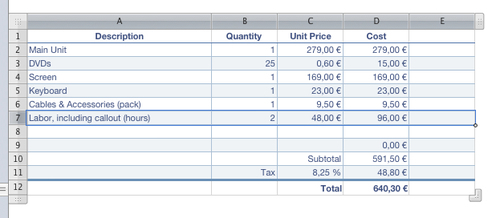If you mostly use word processing, you may be expecting that you will have to learn a new set of techniques when you try Numbers. However, many operations with cells, rows, and columns are very similar to what you are already accustomed to when working with text.
This recipe describes how to change the order of columns and rows in a simple table by dragging—similar to how we drag selected chunks of text from one position to another.
Let's prepare a sample invoice, which includes several items. We can use the Numbers invoice template, which has rows for merchandise and other chargeable items, and columns for quantity, unit price, and cost. The template automatically calculates the subtotal, VAT (if applicable), and the total sum to invoice. The example shown in the following screenshot shows money in Euros, but other world currencies are available in Numbers. Highlight cell(s) and open Inspector. Then, choose Cells Inspector, and pick the appropriate currency symbol.
You may have listed labor costs first, but have now decided to put them at the end of the final invoice.

Follow these steps to rearrange the rows:
- Click on the table showing the prices to select it. The table shows numbered rows, with numbering starting at the row with the column headers. Columns are referenced in alphabetical order.
- Click on number 2—on the digit (the reference tab) itself. This selects the row. Let go of the mouse button.
- Click on it again, hold, and drag the row to the new position, for example, to the row after all other items. As you drag, the insertion point for the row gets highlighted as a thick blue line. Let go, and the row takes the new position. The numbering of the rows adjusts automatically.
Use the same steps to rearrange columns, for example, if you want to put total cost first and break down the unit price and quantity afterwards.
The numbers and letters that index the rows and columns are called reference tabs. They only appear when we work on the table and stay invisible on printouts and PDFs.
If you click on the row number (reference tab) and immediately start dragging, you will not move the row or column but select adjacent rows or columns. This may feel annoying at first, but it only takes a short time to remember to make a slight pause before clicking again on the number or letter (reference tab) before beginning to drag.
We can copy and paste columns, rows, and cells. Click inside a cell, for example, the one showing the labor costs, and type Command + C. In a different invoice, where the labor cost cell is empty or shows a different sum, click on that cell and type Command + V to paste. The sum will change to the one you have pasted.
We can copy and paste the contents of several cells at a time. Select the cells to copy, type Command + C, select the destination cells, and type Command + V. Options to cut, copy, and paste are also available under the Edit menu.
If you want to paste cells, columns, or rows without replacing the existing ones, you can add copied cells, columns or rows via the Insert menu. Choose Insert | Copied Columns or Insert | Copied Rows, and a new row or column will be added.
